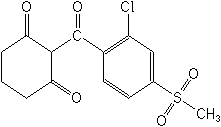-
Common NameSulcotrione
-
中文通用名磺草酮
-
IUPAC2-(2-chloro-4-mesylbenzoyl)cyclohexane-1,3-dione
-
CAS2-[2-chloro-4-(methylsulfonyl)benzoyl]-1,3-cyclohexanedione
-
CAS No.99105-77-8
-
Molecular FormulaC14H13ClO5S
-
Molecular Structure
-
Category
-
ActivityHerbicide
Sulcotrione is primarily a systemic, post-emergence herbicide. However, it also has some residual soil activity, remaining in the top layer of the soil to be activated by rainfall. Grass weeds are best controlled with early post-emergence applications. Plant death occurs within ten days of treatment. The product has shown no cross-resistance to atrazine-resistant species. Sulcotrione may be used for pre-emergence applications in flax. No visible injury or negative effects on yield have been noted.
Sulcotrione is selective to maize and sugar cane. -
CropUseCropUses:
maize, sugar canes, flax
Maize: 300-450 g ai/ha
Flax: 600 g ai/ha
-
PremixPremix Parters: propanil; pyrazosulfuron-ethyl;
Type
AI concn
Suspension concentrate (SC)
30% (w/v)
-
Physical PropertiesMolecular weight:328.8; Physical form:White solid; (tech. is a light tan solid). Composition:Tech. material is 90% pure. Melting point:139 °C; (tech., 131-139 °C); Vapour pressure:5 × 10-3 mPa (25 °C); Henry constant:9.96 × 10-6 Pa m3 mol-1 ( calc.); Partition coefficient(n-octanol and water):logP <0 (unspecified pH); pKa:3.13 (23 °C); Solubility:In water 165 mg/l (25 °C). Soluble in acetone and chlorobenzene.; Stability:Stable in water, with or without exposure to sunlight. Thermostable up to 80 °C.;
-
ToxicologyOral:Acute oral LD50 for rats >5000 mg/kg. Percutaneous:Acute percutaneous LD50 for rabbits >4000 mg/kg. Low rate of absorption through the skin; non-irritating to skin; mild eye irritant (rabbits). Strong skin sensitiser (guinea pigs). Inhalation: LC50 (4 h) >1.6 mg/l.
-
Environmental ProfileEcotoxicology:?
Algae:EC50 (96 h) for Selenastrum capricornutum 1.2 mg/l.Bees:Low toxicity to bees, both by topical and oral application; LD50 >200 μg/bee.Birds:Dietary LC50 for bobwhite quail and mallard ducks >5620 mg/ kg.Daphnia: LC50 (48 h) >200 mg/l.Fish: LC50 (96 h) for rainbow trout 227, mirror carp 240 mg/l.Worms: LC50 (14 d) >1000 mg/kg soil.?
Environmental fate:?
Animals:Rapidly excreted in the urine, the major metabolite being 4-hydroxysulcotrione.Soil:Rapidly degraded in soil; lab. DT50 15-74 d; field DT50 1-11 d. The major metabolite is 2-chloro-4-methylsulfonylbenzoic acid.Koc 44 (high pH, sandy clay lPlant:Deactivated by the formation of 2-chloro-4-methylsulfonylbenzoic acid.
Mallard duck
LD50 >1,350 mg/kg Bobwhite quail LD50 >2,250 mg/kg
Mirror carp [96 hrs]
LC50 240 mg/litre Daphnia [48 hrs] LC50 100 mg/litre
Rainbow trout [96 hrs]
LC50 227 mg/litre Bee [contact] LD50 >200mg/bee
Fate in :
Fate in soil:
Sulcotrione is primarily degraded by microbes. The half-life in soil is typically 10-15 days in the field.Fate in aquatic systems:
Sulcotrione degrades in water. -
Transport InformationHazard Class:O (Obsolete as pesticide, not classified)
Porduct NewsMore
Orthosulfamuron boosts sugarcane production, study finds
Glyphosate price plummets 40% in one year in Argentina
Indian govt stops imports of herbicide Glufosinate priced below Rs 1,289 per kg
Carbendazim fungicide wins victory in Brazilian Parliament
Corteva presents new pre-emergent herbicide Linear for sugarcane in Brazil
Picloram Triclopyr Aminopyralid
Revolutionizing disease prevention: BASF launches new rice fungicide Cevya® in China
Thiamethoxam is allowed again in Brazil by a judicial decision
Bayer develops alternative to glyphosate herbicide
Related CompaniesMore
Zhejiang Udragon Pesticides and Chemicals Co., Ltd.
Country: China
Boscalid Fludioxonil Metconazole Famoxadone Tetraconazole Trifloxystrobin Clodinafop-propargyl Mefenpyr-diethyl Difenoconazole

 0
0 Subscribe
Subscribe
